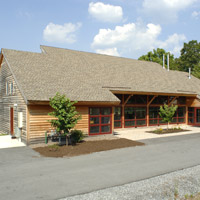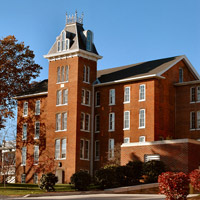LEED Certified Buildings
Juniata is proud to offer students an opportunity to learn at Shuster Hall at Raystown Field Station, a LEED certified building. Construction was completed in 2003, and Juniata already has plans for another LEED certification.
What does LEED mean?
LEED stands for Leadership in Energy and Environmental Design, and is considered the benchmark for the design, construction, and operation of high performance green buildings. The LEED Green Building Rating System uses a point system to determine the level of rank a building will be. The rating is determined by the number of points a building gets, which are calculated by looking at different aspects like construction activity, water efficiency, energy use, material and resource allocation, indoor environmental quality, and innovation and design process.
Shuster Hall at Raystown Field Station
Shuster Hall, a LEED Certified building, was the first licensed green building for Juniata. Located on Raystown Lake, Shuster Hall serves as a dining hall and classroom for students participating in the immersion semesters. It also serves as a location for several outreach and educational programs, and provides a space for student and faculty research. Listed below are some of the sustainable components of Shuster Hall:
- Composting toilets and waterless urinals
- Passive solar heating
- Pulse boiler
- Local materials (wood siding, fireplace stone, maple flooring)
- Recycled materials (decking, paint, steel, ceramic tiling) – 35% of the materials contain at least 20% post consumer waste
- Designed to use 30% less energy and 65% less water than other buildings of its size
Founders Hall
Founders Hall once served as the original student housing as well as academic classrooms for Juniata, but now serves as an administration building, housing the offices of the President, Dean of Students, Registrar and Alumni Affairs. In 2008, construction will begin to renovate Founders, doing so in a sustainable way that will lead to LEED certification. The following changes will be made to make the building more environmentally friendly:
- Geothermal energy
- Alternative transportation (bicycle storage and changing facilities)
- Water efficient landscaping
- 20% water use reduction
- Regional materials
- Low emitting materials (paints, coatings, sealants and carpet systems)



